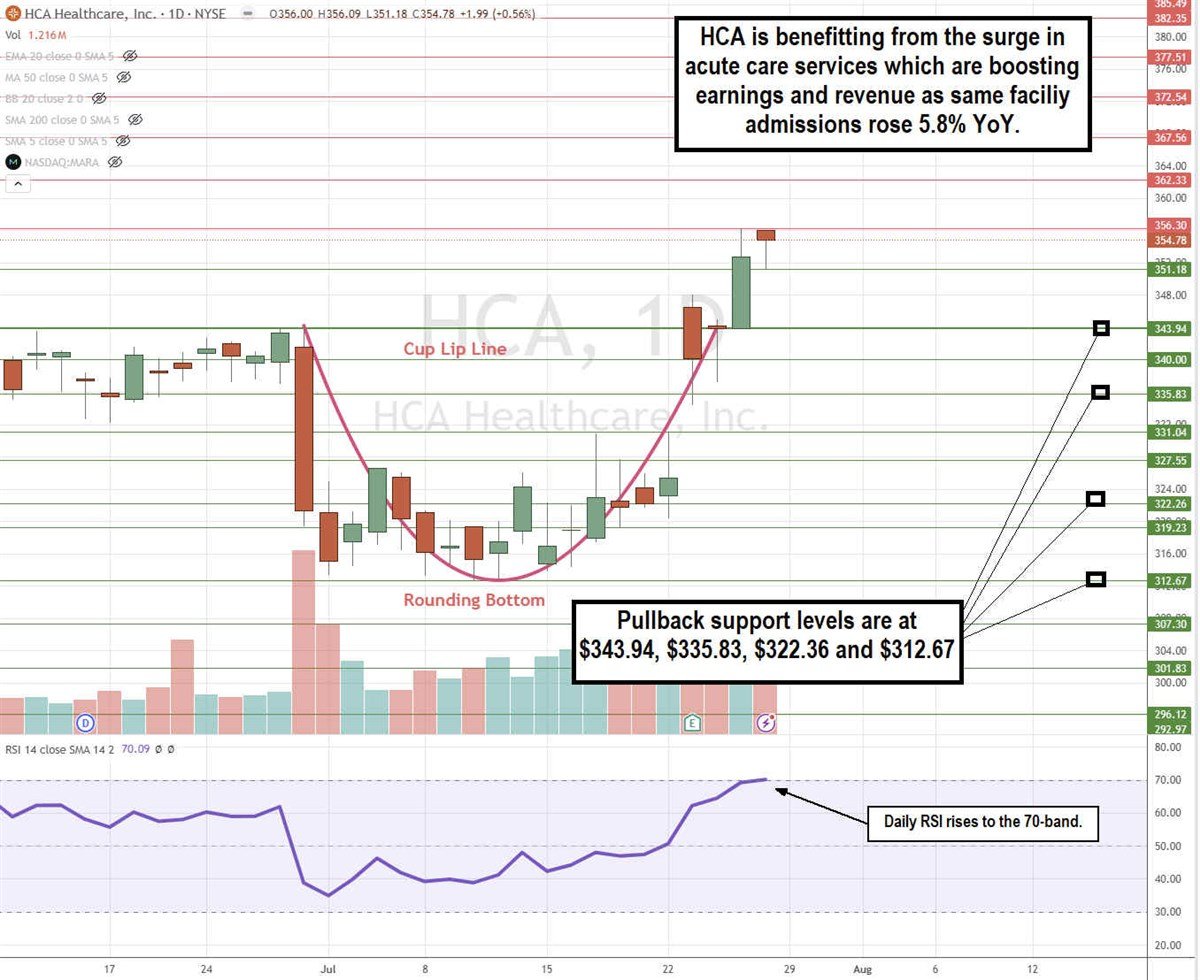TickerTalk Headlines for July 30th
In this newsletter:
Why This Manufacturer is Committing to a Massive Buyback Program
The market is still going on about the technology sector; all the hype around artificial intelligence is starting to cool down as there is a systemwide rotation into other areas in the financial markets. Wall Street giants like Stanley Druckenmiller revealed some of these areas, as he sold out of technology and into two main areas.
One area where Druckenmiller found upside potential was small-cap stocks, which he allocated to the iShares Russell 2000 ETF (NYSEARCA: IWM) since small businesses typically outperform during a new interest rate cycle. Solidifying his view on the Federal Reserve cutting interest rates, Druckenmiller also bought the iShares 20+ Year Treasury Bond ETF (NASDAQ: TLT). Here’s what investors need to know about lower interest rates.
They also bring on lower mortgage rates and higher commodity prices, among other things. Gold prices are now at an all-time high, and nations like China keep stockpiling the precious metal, which, believe it or not, will be a bullish indicator for one stock in the construction industry. Caterpillar Inc. (NYSE: CAT) management knows what’s coming, and they’re putting a few billion aside to squeeze the potential rally.
Gold Reserves and Construction: An Unexpected Relationship
Countries need to be able to print money and finance their projects by selling bonds to other countries. However, other countries might not want to invest in a weak currency or economy since it’ll probably be a bumpy road. A country can create confidence for potential financiers by increasing its foreign currency reserve or stockpiling gold.
Investors should monitor the relationship between the countries importing a lot of gold and increasing their infrastructure and construction budgets. Why? Caterpillar might be in the middle of an action that will spike worldwide, and being an international company sometimes has its perks.
Turkey, India, and China are among these countries. Not only have they been stockpiling gold lately, but they have also continuously increased their construction and infrastructure budgets. Another thing these countries have in common is that all three of them import their machinery from Caterpillar.
To tie it all together, investors should know that lower interest rates could also bring a downside to the dollar index. A weaker dollar will boost exports as foreign currencies are stretched to buy more American goods, increasing earnings for stocks like Caterpillar.
The Clear Uptrend in Caterpillar Stock
Starting with price action and momentum, Caterpillar stock trades at 92% of its 52-week high price. Still, some in the market believe it could go even higher, even a new all-time high, as the previous was $382 a share.
Analysts at Goldman Sachs still stand by their price target for Caterpillar stock, set at $408 a share. This target not only calls for a new all-time high but also dares the stock to rally by as much as 16.4% from where it trades today.
The forecast for Caterpillar stock’s earnings per share (EPS) is set to grow at only 5.7% in the next 12 months, which might be on the conservative end of the spectrum and due for a revision, particularly considering the sorts of tailwinds that are about to hit the company’s financials.
But these analysts aren’t the only ones in the market willing to share their optimistic views with the public. Investors can decrypt the market’s message about a company’s value. In the case of Caterpillar, one valuation multiple makes it a clear positive outlier compared to the rest of the industrial sector.
Trading at a 9.1x price-to-book (P/B) ratio commands a premium of over 150% compared to the industrial sector’s average 3.7x P/B valuation today. There’s typically a reason why markets will bid a stock near a new all-time high while also paying a premium valuation, and investors now have a good idea of what that reason may be.
Caterpillar Management's Bold Bet on Future Growth
Based on these tailwinds, Caterpillar management approved a $21.8 billion buyback program. This program is a bet that the company is cheap today compared to what it could be valued shortly.
Investors can use Caterpillar's first quarter 2024 earnings presentation to justify this buyback program, as the company is now riding on significant financial momentum. The key takeaways were a 29% annual jump in operating profits and a 54% jump in EPS (which is significantly above analyst forecasts).
These gold stockpiling nations, readying for a construction spree, might have already placed their interests in Caterpillar's machinery. Order backlog rose by $400 million over the quarter, which, of course, gave management confidence to increase their guidance for the rest of the 2024 fiscal year.
Musk warns humanity: "Obsolete" (Ad)
The 'invasion' I've discovered has nothing to do with the border crisis. What's happening at our southern border is a travesty, but the 'invasion' I've found will have 10 times greater effects on our economy, and ultimately our way of life.
Go here to see why. >Top 2 Cheap Healthcare Stocks to Buy as Sector Outperforms
As the second half of the year has gotten underway, the healthcare sector, represented by the XLV ETF, has seen a notable resurgence. This sector, which had been underperforming since the pandemic, is now breaking out of a multi-year consolidation phase. In July alone, the XLV ETF surged almost 3%, while the overall market, as represented by the SPY, declined by 0.2%. This rotation of capital into healthcare highlights a renewed interest in the sector, which has primarily lagged in recent years.
What is the XLV?
The Health Care Select Sector SPDR Fund (NYSE: XLV) closely tracks the returns and characteristics of the S&P Health Care Select Sector Index. This index includes companies from various industries, such as pharmaceuticals, healthcare providers and services, healthcare equipment and supplies, biotechnology, life sciences tools and services, and healthcare technology.
The fund has a significant exposure to the U.S. market, with 97.5% of its holdings based there. The industry breakdown consists primarily of 47% in biotechnology, 28% in healthcare equipment and supplies, and 20% in healthcare providers and services. The XLV holds companies with an aggregate rating of Moderate Buy, based on 753 analyst ratings over the past year, covering 50 companies. The consensus price target for XLV is $162.34, indicating a potential upside of 8.25%.
A Look Back: Two Years of Sluggish Performance
For the past two years, the healthcare sector struggled to gain traction, with the XLV ETF trading in a consolidation range between $120 and $140. This lack of momentum was stark, especially when compared to the robust performance of the tech sector. The underperformance can be attributed to several factors, including regulatory uncertainties, pressure on drug pricing, and a post-pandemic shift in investor focus away from healthcare. Additionally, the sector faced challenges from increased competition and slow growth in specific segments, such as pharmaceuticals.
Technical Analysis: Breaking Out of Consolidation
From a technical perspective, the healthcare sector has shown a significant shift in momentum. After two years of sideways movement, the XLV ETF has recently broken out above the $140 level, which had acted as a significant resistance. The ETF is now up 9.96% year-to-date, approaching double-digit gains and trading within 1% of its all-time highs. The recent price action, including turning the previous resistance level into support, confirms a strong uptrend. Moreover, net fund flows into the ETF have turned positive, with a 1.28% increase over the past month, signaling growing investor confidence and momentum in the sector.
2 Cheap Outperforming Healthcare Stocks
Pfizer's Recent Stock Performance and Potential Rebound
Pfizer Inc. (NYSE: PFE) has experienced a significant decline, falling over 50% from its pandemic highs. However, the stock recently crossed above its flattening 200-day SMA, signaling a potential bottom. PFE has surged 12.22% this month in the short term, breaking out of a long-term downtrend that began in early 2023. With a forward P/E of 11.31 and a generous dividend yield of 5.46%, Pfizer is an attractive option for value and income-focused investors. Despite a consensus Hold rating based on 13 analyst ratings, the stock has a consensus price target that suggests an additional 12.12% upside.
Pfizer recently achieved more U.S. FDA approvals than any other healthcare company and entered an aggressive 18-month launch period, introducing 19 new products or indications. Management sees significant opportunities, especially in oncology, aiming to have eight or more blockbuster cancer drugs on the market by 2030.
Johnson & Johnson's Potential Move Toward All-Time Highs
Johnson & Johnson (NYSE: JNJ), the third-largest holding in the XLV ETF with a 6.89% weighting, recently found strong support near the $140 level and has since bounced sharply. This month, the stock is up 9.4%, significantly outperforming the sector and the broader market.
Following a solid earnings report, JNJ has seen a rapid increase in value, indicated by a slightly elevated RSI, and is nearing significant resistance around $162. However, if the stock can consolidate near this resistance level and continue to show relative strength, a move toward all-time highs could be possible as the year progresses. In its most recent earnings report on July 17th, 2024, Johnson & Johnson reported an EPS of $2.82, beating the consensus estimate of $2.71 by $0.11. The company earned $22.45 billion in revenue for the quarter, exceeding analyst expectations of $22.33 billion and reflecting a 4.3% year-over-year increase.
Trump is sounding the alarm (Ad)
Europe is one of the latest to release a central bank digital currency and along with it, new cash rules. Christine Lagarde, President of the European Central Bank, shared "Now we have in Europe this threshold, above 1,000 euros you cannot pay cash… if you get caught you are fined or you are going to jail".
Are you prepared?
Healthcare Stock Rides the Acute Services Phenomenon to New Highs
The nation's largest hospital operator, HCA Healthcare Inc. (NYSE: HCA), surged to all-time highs following its strong Q2 2024 earnings results. The dramatic growth in acute care services has driven hospital stocks to new highs, often at the expense of health insurers. Acute care services are usually short-term and intensive hospital-based services that include the emergency room (ER) or intensive care unit (ICU), encompassing surgery, trauma, and maternity care. These are expensive trips that usually require specialized equipment and a team of healthcare providers.
HCA Healthcare operates in the medical sector, competing with hospital operators such as Tenet Healthcare Co. (NYSE: THC), Community Health Systems Inc. (NYSE: CYH), and Universal Health Services Inc. (UHS).
The Acute Care Surge Phenomenon and What It Means for HCA
If you haven't noticed, hospital stocks are trading at record levels these days. HCA Healthcare stock is up 31%, outperforming the S&P 500 Index, which is up 14.54%. This can feel disjointed when health insurance stocks like Humana Inc. (NYSE: HUM) and CVS Health Co. (NYSE: CVS) are trading down 14.2% and 22.7% year-to-date (YTD), respectively. The phenomenon is caused by the unexpected dramatic surge in acute care (sometimes referred to as inpatient utilization) that started in the second half of 2023. This caused Humana to issue a surprise guidance cut after experiencing a spike in inpatient utilization among its Medicare Advantage plan members.

HCA Completes a Cup Pattern to New Highs
The daily candlestick chart for HCA illustrates a cup pattern. This cup lip line formed at $343.93, which was double top resistance. HCA peaked out there on June 28, 2024, as shares fell to a swing low of $312.67, where it formed a rounding bottom. HCA staged another rally back to retest the cup lip line and finally triggered the breakout following its Q2 2024 earnings release. The daily relative strength index (RSI) has risen to the 70-band. Pullback support levels are at $343.94, $335.83, $322.36, and $312.67.
HCA Healthcare Crushes Top and Bottom Line Estimates
HCA Healthcare reported Q2 2024 EPS of $5.50, beating consensus estimates by 57 cents. Revenues rose 10.3% YoY to $17.49 billion, beating $17.05 billion consensus analyst estimates. Adjusted EBITDA totaled $3.55 billion compared to $3.056 billion in the year-ago period. Cash flows from operating activities were $1.971 billion.
The same-facility growth metrics give an idea of the growth in acute care services. Same-facility admissions grew 5.8% YoY, and same-facility equivalent admissions rose 5.2% YoY. Same-facility emergency room visits rose 5.5% YoY. Same-facility inpatient surgeries rose 2.6% YoY, while same-facility outpatient surgeries fell 2.1% YoY. Same-facility revenue equivalent admissions increased 4.4% YoY.
HCA Healthcare: Raising the Bar for Full-Year 2024
HCA Healthcare revised and raised its full-year 2024 guidance. Revenues were guided higher to $69.75 billion to $71.75 billion, up from the previous estimate of $67.75 to $70.25 billion, versus $69.73 billion consensus estimates. Net income attributable to HCA Healthcare Inc. was raised from $5.675 billion to $5.975 billion, up from $5.2 billion to $5.6 billion. Adjusted EBITDA was raised from $13.75 billion to $14.25 billion, up from previous guidance of $12.85 billion to $13.55 billion. Full-year 2024 EPS estimates were raised to $21.60 to $22.80, up from previous guidance of $19.70 to $21.20 versus $20.92.
Invest in HCA as CEO Highlights Revitalization Success
HCA Healthcare CEO Sam Hazen noted that the 2% decline in outpatient surgeries in the first quarter was due to lower volumes in Medicaid and self-pay categories. ER volumes increased due to strong growth in cardiac procedures and inpatient rehab services. The acuity of inpatient services was reflected in the case mix index, which increased slightly over last year, helping generate same-facility revenue growth of 10% YoY.
Hazen commented on ER growth, “Our commercial volumes in the emergency grew almost 18%. So really strong growth in that category. Again, we are focused on throughput, patient satisfaction, and high clinical performance with what we call our ER revitalization program. And our ER revitalization program has produced positive results for us.” This program consists of boosting efficiency and cutting down times, such as seeing a patient from 11 minutes to 9 minutes. The length of stay for discharged patients is down 15% to 20% and is around 160 minutes.
HCA Healthcare analyst ratings and price targets are at MarketBeat. There are 19 Wall Street analyst ratings on HCA stock, comprised of one Strong Buy, 14 Buys, and four Holds.
Breaking News: Elon Musk Invents New Type of A.I. (Shocking) (Ad)
Could Elon's New Device be Bigger than the iPhone?
According to 30-year Silicon Valley and Wall Street veteran, Eric Fry…
This mind-blowing new technology could be bigger than the iPhone.






没有评论:
发表评论